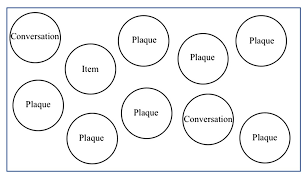Article Link: Computing for all?: Examining critical biases in computational tools for learning
In the study, Litts et al. (2021) examined the affordances and constraints of a novice programming platform called Augmented Reality and Interactive Storytelling (ARIS) for community storytelling in a summer workshop with forty-seven Native American youth (38 fully consented to participate in the research). The indigenous youth built their place-based stories on a storyboard and then developed their games using ARIS. The researchers reported three cases underlying different narrative structures that youth used in their storyboards and the design process while using ARIS:
1- Branching narrative: In this structure, the students follow the linear flow where the player is guided from one element to the next. They were able to execute their game with ease as their structure aligned well with the logic embedded in the platform.

Screen capture of “Figure 2: group students work using the existing branching logic in the ARIS editor” ( Litts et al., 2021, p.850).
2- Sandbox narrative: In this narrative structure, the students desired to give the player a big open world populated with opportunities for exciting interactions. The player isn’t constrained to a rail-like linear plot but can interact with the world in any order that he/she chooses. While the idea is doable, however, it requires a certain level of familiarity with ARIS and computer science principles that the students lack. Thus, the students couldn’t work out their idea on the platform, and the result was a narrative that they didn’t initially intend.

Screen capture of “Figure 3: Visual representation of sandbox narrative structure” (Litts et al., 2021, p.851).
3- Hub-and-spoke narrative: it is a non-linear narrative tightly connected to the Indigenous culture. Also, here, the group of students couldn’t execute the game as desired (only completed one spoke) as the structure of the tool didn’t support the form of their narratives (Litts et al.,2021).

Screen capture of “Figure 4: Visual representation of hub-and-spoke narrative structure” (Litts et al., 2021, p.852).
The latter two cases explicate the epistemological tensions in this computational tool (its Western orientation), which negatively impacted these groups’ participation in computing. The message that stood out for me in the article is that “it is not enough just to broaden who participates in computing; we must also broaden the epistemologies and cultural practices that are valued within computing. As such, we must expand who designs tools in the first place” (Litts et al., 2021, p.853). The article is significant to my research project as it considers the design of learning tools as a core pillar in broadening the participation of Indigenous students in the computing field and reveals that more efforts are needed to design culturally responsive computational tools.
Reference:
- Litts, B. K., Searle, K. A., Brayboy, B. M. J., & Kafai, Y. B. (2021). Computing for all?: Examining critical biases in computational tools for learning. British Journal of Educational Technology, 52(2), 842-857. https://doi.org/10.1111/bjet.13059